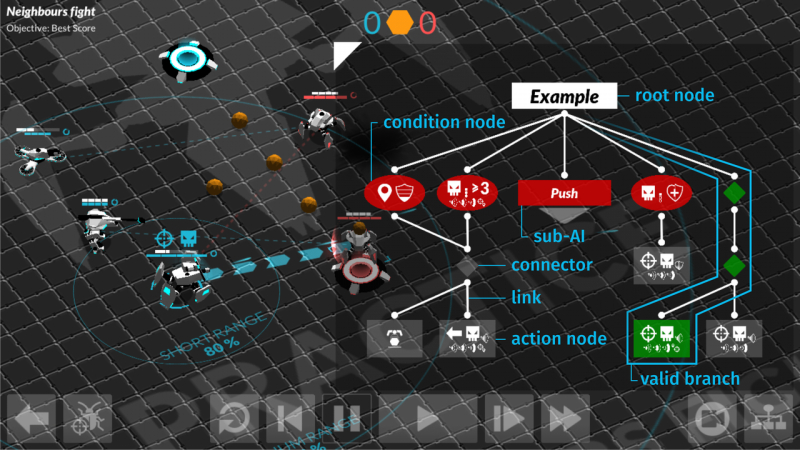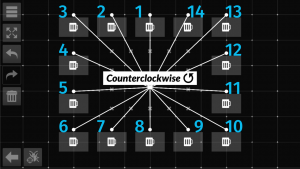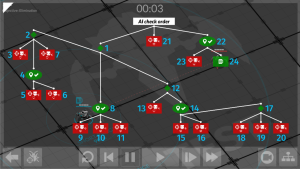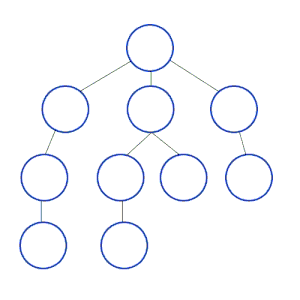 |
|
This page needs improvement, you are welcome to contribute.
|
Basics
The robots in Gladiabots are autonomous and obey their Artificial Intelligence (AI). Bots can only execute one of the possible actions at a time. The AIs task is to determine what action to use in the current situation. Each bot checks its AI counterclockwise, searching for the first valid branch leading to an action.

The AI of a bot is shaped like an upside down tree. It can be composed of the following elements:
| Element |
Description
|
| Root node |
Each AI contains exactly one root node that defines the starting point of the AI check. Nodes linked from the bottom of the root node are evaluated counterclockwise. The root node indicates the name of the AI.
|
| Action node |
If a rectangular-shaped action node is evaluated valid during AI check, the described action is executed for the current tick. An action node is considered invalid if the bot cannot perform it . .
|
| Condition node |
If an oval-shaped condition node is evaluated valid during AI check, the nodes linked from the bottom of the condition node are evaluated counterclockwise. A condition node is considered invalid if the current situation doesn't fit it . .
|
| Connector node |
The diamond-shaped connector node is always evaluated valid during AI check. It connects every node linked to the top of the connector node with every node linked from the bottom of the connector node. A connector node can be used to simplify the layout of the AI.
|
| Sub-AI node |
One can reuse an AI inside another one, by using a Sub-AI node. When evaluating this node the whole sub-AI is checked for a valid action. A sub-AI can again contain its own sub-AIs.
|
| Link |
Nodes can be connected with a link. A link is a directed connection from the bottom of one node to the top of another node to the top of another node . .
|
AI checking process

Nodes are evaluated counterclockwise

Branches are explored with depth-first search
To determine the action a bot should use in the current situation, the valid nodes are traversed by a depth-first search algorithm beginning with the root node:

 |
|
| Details of the AI checking process
|
|
Use the root node as reference node and start at step (1):
- 1) Get a list of all subnodes linked from the bottom of the reference node. Traverse this list of subnodes ordered counterclockwise
 : :
- 1a) If the current subnode is an action node and evaluated valid, then the AI checking is discontinued as a valid action is found.
- 1b) If the current subnode is a sub-AI, then this sub-AI is evaluated. If a valid action is found in it the AI checking is discontinued.
- 1c) If the current subnode is a condition or connector node and evaluated as valid, then use this subnode as reference node and start a recursive evaluation at step (1). If no valid action is found there, continue at step (1d) afterwards.
- 1d) If there are further subnodes in step (1) continue with the next subnode at step (1a).
- 2) If there are no further subnodes in step (1), try to backtrack to the previous evaluation in step (1c). If there is no previous evaluation no valid action could be found. The bot idles instead.
|
|
 |
|
Branches are not executed counterclockwise but checked counterclockwise.
|
 |
|
The evaluation of nodes is instant and is not wasting any time from the current tick.
|
Best practices for AI design
Some best coding practices from software development also apply to AIs in Gladiabots. The following rules can help improve the quality of AIs, enhancing both the initial development and subsequent maintenance of the AI.
 |
|
| Divide and conquer
|
|
Break down a problem into two or more sub-problems and solve each of them separately. Complex sub-problems can again be divided. In Gladiabots this could be done by creating sub-AIs for each sub-problem. The complexity is reduced leading to a better maintainability.
|
|
 |
|
| Readability
|
|
AIs are written once, but read many times. Overlapping nodes and crossing lines should be avoided.
|
|
 |
|
| Don't repeat yourself.
|
|
Avoid using the exact same nodes in several places. Sometimes duplicate nodes can be prevented by using bot specific filters or additional conditions. If its not possible to prevent duplicate nodes in the first place one can try to move them to sub AIs.
|
|
 .
.
 .
.
 to the top of another node
to the top of another node .
.



